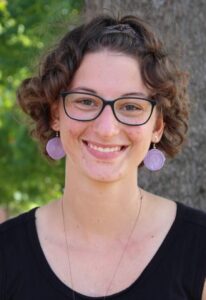 By Madeline Troyer
By Madeline Troyer
While hiking the Great Smoky Mountains on the Appalachian Trail, I wrote in my journal: “It’s amazing how much the forest can change in a day, for a while we were on a ridge with small trees ancient trees, then a pine forest, now hardwoods, clusters of beech trees, a different type of pine forest, forest made of big strong trees, tunnels of rhododendron, and so many others I can’t describe.”
Alongside these stands of trees, diverse communities of fungi, slime mold, birds, salamanders, rocks, and other life thrived. Each ecosystem remains vivid in my memory.
“Trees, the same age as me, are using resources to call back the life that left the barren fields they are changing.”
These forests are often understood as unique and separate worlds. But, as I walked from Georgia to Maine, I realized how these forests were connected as a larger system – a green corridor made up of unique individuals all acting towards a larger goal.
MY CONNECTION TO forest systems started the year before I was born when my Dad first started his tree-growing journey on our property by planting a small mix of pines and hardwoods. Over my lifetime, my Dad – ever dreaming of spaces to continue his passion – has planted more than 3,500 trees.
The state regularly provides us with bundles of what looks like dead sticks with roots. Holes are dug and the small seedlings are tramped into place. The next two years involve stomping back waist-high weeds so the small trees can emerge in order to reach the sunlight. (It’s hard to imagine what all of this hard work is for when I can barely find the tree among weeds.)
“This week I picked up leaves as I walked around our neighborhood reflecting on the lessons dropped on me from the trees.”
Looking out across the property, I can see the trees planted in 1996, now a forest full of owls that did not fly there when I was born and delicate pink spring beauties that have slowly replaced the invasive multiflora rose. Trees, the same age as me, are using resources to call back the life that left the barren fields they are changing.
As I walk through forests and the air moves around me, ranging from a gentle breeze to the strong wind, I listen to the trees dance while reflecting on Isaiah 55:12, where the trees respond to the joy of the Lord with songs and clapping. From Georgia to Maine the types of forests are very different, but all are connected. Old trees and new each started with a struggle for life and a dream to come. Roots are connecting underground, forming communication systems that scientists are only recently starting to understand. A community joined together as the lungs for our world provides not only clean air but habitat, food, medicine, energy, and an ethos of placemaking.
This week I picked up leaves as I walked around our neighborhood reflecting on the lessons dropped on me from the trees – the importance of diversity, of clinging to a dream of a better life and struggling through dark shadows to find the light, of community with each other and interaction with the larger systems that connect us, of giving all that we have as we move together with the wind celebrating and proclaiming with joy all that we are growing to become. I take some of the fall leaves home praying that some of their wisdom would continue to enter into me as a member of the larger ecological community.
